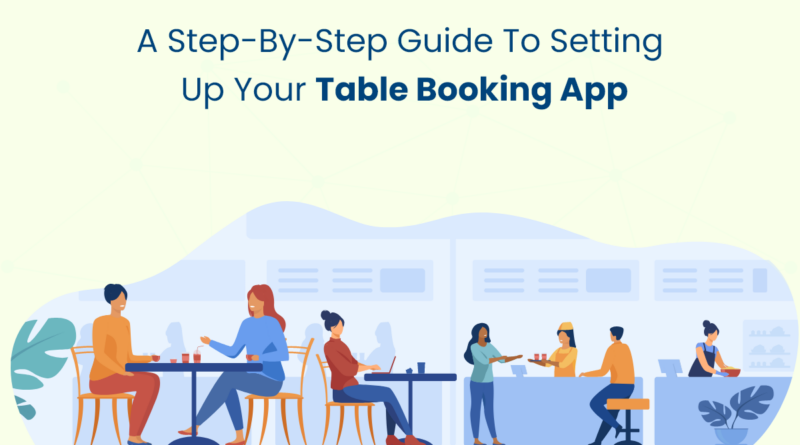A Step-by-Step Guide to Setting Up Your Table Booking App
In the digital age, offering a seamless table booking experience is essential for running a successful restaurant. A table booking app can streamline your operations, improve customer satisfaction, and increase revenue. However, setting up a table booking app can feel overwhelming if you’re unfamiliar with the process. This step-by-step guide will walk you through everything you need to know about setting up your table booking app efficiently.
Why You Need a Table Booking App
Before diving into the setup process, it’s important to understand why having a table booking app is beneficial for your restaurant. Here are some of the key advantages:
- Enhanced customer experience: Customers can easily book a table at their convenience.
- Improved operational efficiency: Automates the reservation process and helps avoid overbooking or underbooking.
- Increased revenue: More bookings mean more tables filled, leading to higher revenue.
Now, let’s look at the steps you need to follow to set up your table booking app.
Step 1: Choose the Right Table Booking App
Research Available Apps
The first step in setting up your table booking system is choosing the right app. Conduct thorough research to compare different apps based on the features they offer, pricing, and integration capabilities.
Key Features to Look For
When selecting an app, consider the following essential features:
- Real-time availability: The app should allow customers to see available slots and book in real time.
- Customizable booking forms: This allows you to gather important details like customer preferences or special requests.
- Mobile-friendly: Ensure the app works smoothly on both desktop and mobile devices.
- Integration with POS and CRM systems: To streamline operations and manage customer data efficiently.
- Data analytics: Insights into booking trends and customer behavior to inform business decisions.
Sign Up and Subscribe
Once you’ve selected the app that fits your restaurant’s needs, sign up and choose a subscription plan that matches your budget and the size of your restaurant.
Step 2: Customize Your Booking App Settings
Personalize Your Restaurant Profile
After signing up, the next step is to set up your restaurant’s profile within the app. This profile will be visible to customers and should contain key details about your restaurant, including:
- Restaurant name and logo: Helps build brand recognition.
- Contact information: Include your phone number, email, and address so customers can reach you if necessary.
- Operating hours: Set the days and times when your restaurant is open for bookings.
- Reservation Policies: Define any booking rules, such as cancellation policies, table hold times, or group booking limits.
Set Up Table Layout and Availability
You will also need to configure the table layout for your restaurant. Most table booking apps allow you to create a visual representation of your seating arrangements, which can help you manage bookings more efficiently.
- Table capacity: Set the number of guests each table can accommodate.
- Booking slots: Define available time slots for customers to choose from based on your operating hours.
- Special seating requests: Allow customers to request specific tables or seating preferences (e.g., outdoor seating, window seats).
Configure Notifications and Alerts
Notifications are critical to ensure both your team and your customers are kept informed. Most apps allow you to customize notifications for different events, such as:
- Booking confirmations: Automatically send a confirmation message once a reservation is made.
- Reminders: Set up reminder notifications for customers 24 hours or an hour before their booking time.
- Cancellation alerts: Notify customers when their booking is canceled and allow them to rebook if necessary.
Step 3: Integrate the App with Your Website and Social Media
Embed the Booking Widget on Your Website
To make it easy for customers to book a table, you need to integrate the app with your website. Most table booking apps provide a booking widget or a link that you can easily embed into your website. Ensure that the widget is prominently displayed on your homepage or on a dedicated “Reservations” page.
Add a Booking Button to Your Social Media Profiles
In addition to your website, integrating your booking app with your social media profiles can help increase visibility and drive bookings. Add a “Book Now” button on your restaurant’s Facebook or Instagram profile to provide a direct booking option for your followers.
Utilize Google My Business Integration
If your table booking app supports it, integrate it with your Google My Business profile. This way, customers can book a table directly through your Google listing, making it even more convenient for them to reserve a spot at your restaurant.
Step 4: Train Your Staff
Provide Hands-On Training
Once your table booking app is set up, it’s important to train your staff on how to use the system. Provide hands-on training to ensure that your team understands how to manage bookings, handle cancellations, and deal with overbooking or underbooking situations.
Assign Admin Roles
Many apps allow you to assign different roles and permissions to your staff. Designate administrators who can access advanced features like analytics and customer data, and restrict certain functions for other team members to maintain data privacy.
Create a Staff Backup Plan
Ensure that your staff knows how to handle any technical issues that may arise with the app. Create a backup system, such as manually recording reservations, to avoid operational hiccups in case of app downtime.
Step 5: Promote Your New Table Booking App
Announce on Social Media and Email
Once your booking app is fully set up, it’s time to let your customers know! Promote your new system through your social media channels and in your email newsletters. Highlight the convenience of booking a table online and emphasize any features like special offers for those who book through the app.
Offer Incentives for Early Users
To encourage early adoption, consider offering a discount or special promotion for customers who book through your new table booking app. This can help drive traffic and familiarize your customers with the system.
Monitor and Adjust Based on Customer Feedback
After launching the app, gather feedback from customers on their booking experience. If you notice any issues or receive suggestions for improvement, make adjustments to enhance the booking process.
Step 6: Analyze and Optimize
Track Performance with Analytics
Most table booking apps come with built-in analytics and reporting features. Use these tools to track performance metrics such as the number of bookings, peak booking times, and customer demographics. These insights will help you make data-driven decisions to optimize your booking system and overall operations.
Make Adjustments Based on Data
If you notice that certain time slots or tables are consistently underbooked, consider making adjustments. You might promote those slots with special offers or rearrange your table layout to better accommodate customer preferences.
Conclusion
Setting up a table booking app for your restaurant can streamline your operations, increase reservations, and enhance the overall dining experience for your customers. By following these step-by-step instructions—starting from selecting the right app to customizing your settings, training your staff, and promoting your system—you can ensure a smooth and successful integration of your table booking app. Discover how to effortlessly set up your table booking app with our comprehensive guide. Learn from the experts at the top on-demand app development company!




